Normandy 2024, 80 years after D-Day: Each year, there are commemorations of D-Day, but every five year, there are nummerous ceremonies across Normandy to pay tribute to the soldiers who fought here in 1944. Members of the Dutch WWII military vehicles owners association Keep Them Rolling were invited by the French municipality of Lantheuil to attend and contribute to the D-Day celebrations and commemorations in Normandy. Together with other members of Keep them Rolling, we and the WWII vehicles were accommodated on a well equipped camping site. On the second day of June we arrived in Normandy to join the 80th anniversary of D-Day. D-Day, 6 June 1944, was the first day of Operation Overlord, the Allied code-name for the Battle of Normandy, the successful Western Allied invasion in Normandy during WWII and the beginning of the liberation of nazi-Germany occupied Europe. D-Day is known as the largest amphibious invasion in military history. Nowadays, many memorials, cemeteries and museums along the coast of Normandy commemorate D-Day and the Battle of Normandy. We visited a number of museums and memorials, such as the Maisy Battery and the Fortifications of Vauban at Saint-Vaast-la-Hougue, during WWII, the centuries-old fortifications were integrated into the Atlantic Wall. The Normandy Victory Museum was opened in 2017 and is worth a visit, the museum belongs to the major museums in Normandy. We also paid a visit to the British Normandy Memorial, this imposing monument was opened in 2021. On the 4th of June, a static show of WWII military vehicles was held on our camping site for the school children of Lantheuil, organised by the members of Keep Them Rolling. During sunset on the 6th of June, 2024, an impressive commemoration took place on Juno Beach, in front of the Canada House in Bernières-sur-Mer. On the 8th of June, members of the Keep Them Rolling laid a floral wreath at the Memorial, a Sherman DD Tank, in Courseulles-sur-Mer. We went also to Bayeux to visit the world famous Bayeux Tapestry, a 70 metres long medieval embroidery. After a week full of celebrations, we went to Brittany to visit the Standing Stones in Carnac. On our way home, we stopped at the city of Arras to visit the citadel. In the citadel there is a impressive memorial dedicated to 218 members of the French Resistance who were executed by the Nazis in WWII.
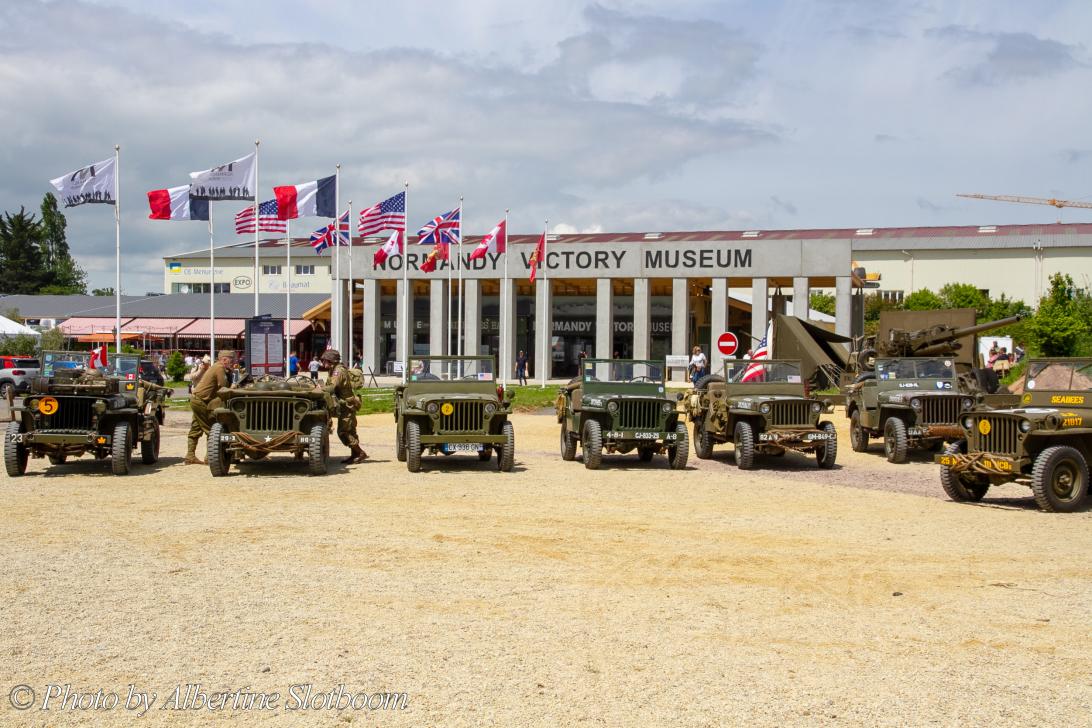
Normandy 2024, 80th anniversary of D-Day: The Normandy Victory Museum was opened in 2017, it is located in Carentan-les-Marais and tells the story of the German occupation and the Battle of the Hedges. Inside the museum there are twenty-seven dioramas, a collection of more than 15,000 authentic World War II objects. In front of the museum, a number of original World War II Jeeps.

Normandy 2024, 80th anniversary of D-Day: The Normandy Victory Museum was opened in 2017, it is located in Carentan-les-Marais and tells the story of the German occupation and the Battle of the Hedges. Inside the museum there are twenty-seven dioramas, a collection of more than 15,000 authentic World War II objects. In front of the museum, a number of original World War II Jeeps.
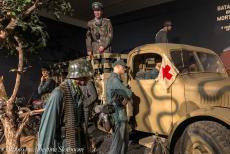
Normandy 2024, 80 years after D-Day: One of the dioramas in the Normandy Victory Museum, the museum is also know as the Battle of the Hedges Museum (Musée de la Battaille des Haies). The Battle of the Hedges took place in July 1944, it was one of the longest and hardest trials for the Allied soldiers. The Normandy bocage landscape, a labyrinth of tiny fields and orchards surrounded by thick hedges and winding holloways was ideal for the German troops to defend.
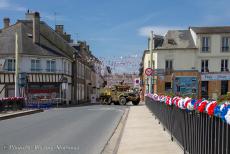
Normandy 2024, 80 years after D-Day: WWII half-track in Isigny-sur-Mer. In the spring of 1944, the town was bombarded twice in preparation for the assault by the American infantrymen, many buildings were destroyed or severely damaged, in total, about 60% of Isigny-sur-Mer was destroyed. Charles de Gaulle landed on Juno Beach on 14 Juni 1944, on the same day, he paid a visit to de inhabitants of Isigny-sur-Mer.
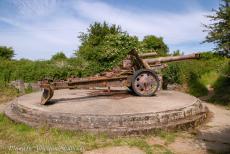
Normandy 2024, 80 years after D-Day: The Maisy Battery comprises more than two km of small shelters, ammunition stores, a hospital bunker, a water well, gun emplacements and trenches. Before D-Day, the battery was already known by the Allied Forces, It was considered to be the 5th most dangerous target on D-Day, the four 155 mm guns could reach both the Omaha and Utah Beach landing areas.
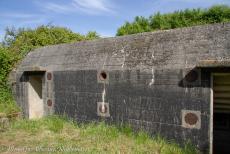
Normandy 2024, 80 years after D-Day: One of the bunkers of the Maisy Battery, a German battery near the village of Grandcamp Maisy. After WWII, the Maisy Battery became overgrown by bushes. In 2006, during the recovery of the site, the mortal remains of a German officer were found. Although his dog-tags were found, his identity is still unknown. In 2009, this unknown soldier has been laid to rest with full military honours at the La Cambe German War Cemetery.
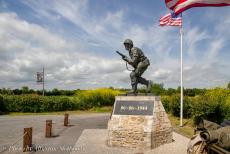
Normandy 2024, 80 years after D-Day: Along the road from Sainte-Marie-du-Mont to Utah Beach stands a monument in memory of Dick Winters, the monument is known as the Major Richard D. Winters Leadership Monument. During WWII, Dick Winters served in the U.S, Army as a paratrooper. Major Dick Winters was immortalized in the book and T.V. series Band of Brothers.
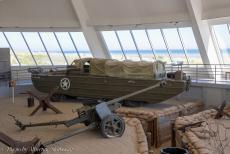
Normandy 2024, 80 years after D-Day: One of the WWII vehicles in the Utah Beach Landing Museum is a DUKW. The DUKW became the main amphibious truck of the Allied Forces in WWII. Between 1942 and 1945, 21,147 DUKWs were built. DUKWS were used for the transportation of goods and troops over land and water. DUKWs were first used during the Allied invasion of Sicily in 1943. During the Invasion in Normandy in 1944, more than 2000 DUKWs were used.

Normandy 2024, 80 years after D-Day: Memorial ceremony on Utah Beach. A bagpipe concert was held on the esplanade of the Landing Museum on Utah Beach. The Utah Beach Landing Museum was built on the spot of a former German stronghold that was destroyed during the American assualt on Utah Beach on D-Day. The Utah Beach Landing Museum owns a collection of authentic WWII objects, an American bomber aircraft, vehicles and personal items of soldiers.
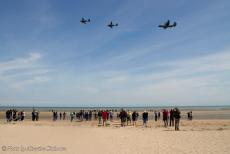
Normandy 2024, 80th anniversary of D-Day: Two Historic Dakotas over Utah Beach. Utah Beach was the codename of the westernmost landing beach of the Normandy Invasion. More than 800 Dakotas were used on D-Day. In the night of 5 June and in the early hours of 6 June, the Dakotas dropped paratroopers behind the enemy lines. These troopes played a crucial role in securing strategic positions such as bridges and crossroads.
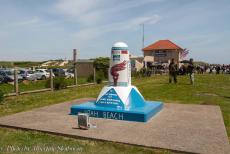
Normandy 2024, 80th anniversary of D-Day: Utah Beach, the Milestone 00 marks the precise landing site of General Theodore Roosevelt Jr. and his men on the morning of 6 June 1944. The Milestone 00 is the beginning of the Liberty Road. The Liberty Road stretches 1147 km from Utah Beach to Bastogne, the entire route is marked every kilometer by a milestone, they mark the main route taken by General Patton's U.S. Third Army in 1944.

Normandy, 80th anniversary of D-Day: The D-Day Sculpture at the British Normandy Memorial at Ver-sur-Mer during sunset. The statue was created by the British sculptor David Williams-Ellis. The D-Day Sculpture is dedicated to the British soldiers who were killed during the Normandy landings. On 6 June 1944, nearly 50,000 soldiers of the 50th British Infantry Division landed on Gold Beach. 'Gold' was the code name for one of the landing beaches during the Allied Invasion.
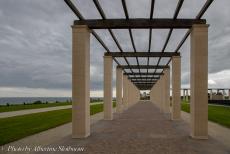
Normandy 2024, 80th anniversary of D-Day: The British Normandy Memorial was opened in 2021. The memorial records the names of the 22,442 people from more than 30 countries under British comand who were killid in Normandy from 6 Juni to 31 August 1944. Their names are engraved on the columns of this imposing monument. The British Normandy Memorial is situated just outside Ver-sur-Mer, overlooking Gold Beach. The memorial is open all year round.
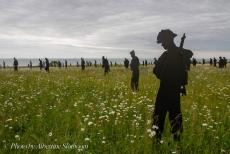
Normandy, 80th anniversary of D-Day: Standing with Giants, metal silhouettes of D-Day soldiers erected at the British Normandy Memorial in Ver-sur-Mer, the almost two metres tall silhouettes commemorate the 1,475 British soldiers who died on the landing beaches of D-Day, the first day of the Allied landings. The silhouettes could be visited until the end of August 2024.
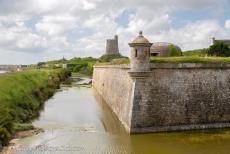
Normandy 2024, 80 years after D-Day: The Fortifications of Vauban in Saint-Vaast-la Hougue. During WWII, the centuries-old fortifications were integrated into the Atlantic Wall, the tower was used by the Germans as an observation tower, the strategic location of the tower provided good views over the sea and the beaches on the Normandy coast. Also several German bunkers were built inside the fortifications, on the right hand side, the dome of a German bunker.
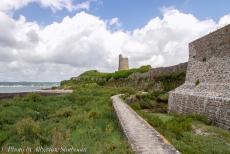
Normandy 2024: Fort de la Hougue and the Vauban Tower. The tower is linked to the Port of Saint-Vaast-la-Hougue by a massieve dam. In WWII, German bunkers were built on the dam and inside the fortress, the bunkers were part of the Atlantic Wall. On 21 Juni 1944, Saint-Vaast-la-Hougue was the first English Channel port to be liberated by the Allies, for a few weeks the port was used by the Allied Forces until the Port of Cherbourg was liberated.
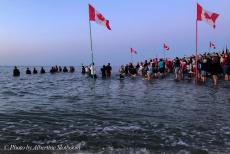
Normandy 2024, 80 years after D-Day: On June 6th, an imposing commemoration took place at the Canada House in Bernières-sur-Mer. As the sun sets over the sea, soldiers and locals waded into the water and saluted to honour the memory of the Canadians who stormed Juno Beach on D-Day. While bagpipes played, wreaths and flowers were placed in the water to memorialize the lives lost on D-Day.

Normandy 2024, 80 years after D-Day: The huge Cross of Lorraine was erected in 1990 on Juno Beach to commemorate the return of General Charles de Gaulle to France. De Gaulle set foot on French soil after four years of exile, he landed on Juno Beach on 14 June 1944. The Cross of Lorraine was the emblem of the Free French Forces, they were led by General de Gaulle. Later, de Gaulle was elected president of France.
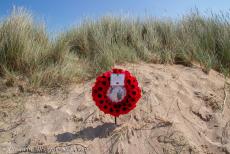
Normandy 2024, 80 years after D-Day: During D-Day and the Battle of Normandy, 73.000 Allied soldiers were killed and some 20,000 French civilians. In Great Britain, the red poppy became the symbol to the fallen British soldiers of World War One, also known as the Great War. Now, the poppy is a memorial symbol to all fallen soldiers worldwide.
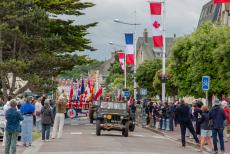
Normandy 2024, 80 years after D-Day: Several WWII military vehicles and their owners took part in the memorial tour and the memorial ceremonies in Courseulles-sur-Mer. Members of Keep them Rolling laid a floral wreath at the monument in Courseulles-sur-Mer, a Sherman DD Tank, which belonged to the 6th Canadian Armoured Regiment.

Normandy 2024, 80 years after D-Day: Courseulles-sur-Mer, a Sherman DD (Duplex Drive) Tank. The tank was recovered from the sea 27 years after D-Day. A Sherman DD Tank was able to sail in the water, it was moved through water by two propellors at the rear, on land reverted into a normal tank. The tank is now dedicated to the 6th Canadian Armoured Regiment (First Hussars).
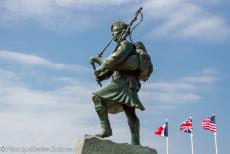
Normandy, 80th anniversary of D-Day: The statue of Piper William 'Bill' Millin at Sword Beach in Colleville-Montgomery. Bill Millin was commonly known as Piper Bill, he was the personal piper to Simon Fraser (the 15th Lord Lovat), commander of the 1st Special Service Brigade. Piper Bill became famous for playing the bagpipes whilst under enemy fire during the D-Day Landings. Bill Millin survived WWII. His bagpipe is on display in the Pegasus Memorial Museum in Ranville.
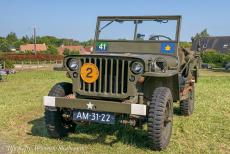
Normandy 2024, 80th anniversary of D-Day: A 1944 Willys MB Jeep of one of the members of Keep Them Rolling, they were invited by the French municipality of Lantheuil to attend and contribute to the D-Day celebrations and commemorations in Normandy. The members of Keep them Rolling and the WWII vehicles were accomodated on a well equipped camping in Lantheuil.
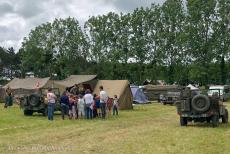
Normandy 2024, 80 years after D-Day: Schoolchildren of Lantheuil paid a visit to our camping site, the children were very interested and wanted to know all about the history of the WWII vehicles. Lantheuil is a small village close to the Normandy Coast, it is located about 15 km from Bayeux and about 17 km from Caen, it lies not far from a number of D-Day memorials, such as the British Normandy Memorial in Ver-sur-Mer and the Ryes War Cemetery at Bazenville.
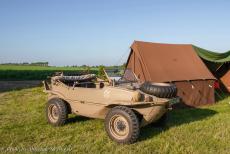
Normandy, 80th anniversary of D-Day: One of the members of Keep Them Rolling is the owner of a Porsche/Volkswagen Schwimmwagen (Swimming Car). The Volkswagen Schwimmwagen is a light four-wheel drive amphibious car. The Schwimmwagen is the most produced amphibious car in history, more than 15,000 were produced from 1941 through 1944. The Schwimmwagen was used by the German Wehrmacht and Waffen SS during WWII. Less than 200 survive today.
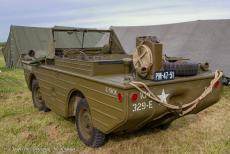
Normandy, 80th anniversary of D-Day: This Ford GPA is owned by one of the members of Keep Them Rolling. A Ford GPA Jeep is the amphibious version of a Ford GPW Jeep. The Ford GPA Jeep is also known by his nickname 'Seep'. During WWII, 12,778 Seeps were constructed. They were used by the Allies during WWII, including the Pacific War, the Invasion of Sicily, the Eastern Front and from D-Day until the end of WWII. How many Ford GPA's remain until today is unknown.
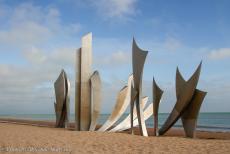
Normandy, 80th anniversary of D-Day: Monument Les Braves on Omaha Beach, Saint Laurent-sur-Mer. The monument consists of three elements: the 'Wings of Hope', 'Rise, Freedom' and the 'Wings of Fraternity'. Anilore Banon, the sculptor of the monument created this imposing memorial to honour the courage of the men who endagered and often sacrificed their lives in the hope of freeing the French people.
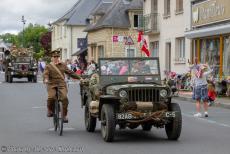
Normandy, 80th anniversary of D-Day: Parade of civil and military vehicles of WWII through the centre of Bretteville-l'Orgueilleuse. A large number of original WWII Jeeps participated in the parade. The Jeep was invented for WWII, the Jeep was the most recognizable and wildely used military vehicle in history. Almost 650,000 Jeeps were produced during WWII. General Dwight D. Eisenhower once attributed the Allied victory in WWII to four things, one of them was the Jeep.
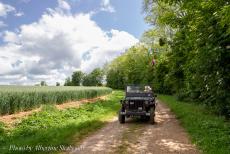
Our own Ford GPW Jeep was produced by the Ford Motor Company in april 1942. When the Allied forces invaded Europe in June 1944 to liberate Nazi-Germany occupied Europe, they used vehicles, such as Jeeps. Our own Jeep was one of them. After landing at Juno Beach just a few weeks after D-Day in 1944, the jeep was used during the liberation of France, Belgium and the Netherlands. The Jeep ended his military journey at Ypenburg Airport in the Netherlands.
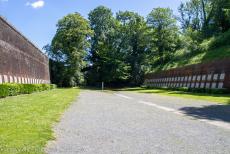
On our way back home from Normandy, we paid a visit to the Citadel of Arras. During World War II, when France was occupied by Nazi-Germany, 218 members of the French Resistance were executed in the dry moat of the citadel. Le Mur des Fusillés is a memorial to honour and remember the French Resistance workers who were killed here by the Nazis between August 1941 and July 1944.
